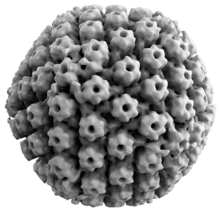| Human alphaherpesvirus 1 | |
|---|---|

| |
| 3D computer reconstruction of capsid | |
| Virus classification | |
| (unranked): | Virus |
| Realm: | Duplodnaviria |
| Kingdom: | Heunggongvirae |
| Phylum: | Peploviricota |
| Class: | Herviviricetes |
| Order: | Herpesvirales |
| Family: | Orthoherpesviridae |
| Genus: | Simplexvirus |
| Species: | Human alphaherpesvirus 1
|
| Synonyms | |
|
Herpes simplex virus 1 | |
Human alphaherpesvirus 1 or Herpes simplex virus 1 (HHV-1 or HSV-1) is a species of virus in the genus Simplexvirus, subfamily Alphaherpesvirinae, family Herpesviridae, and order Herpesvirales.[1]
YouTube Encyclopedic
-
1/5Views:119 09074 676324 3245 31271 784
-
HSV 1 and 2 - Pathogenesis of Oral and Genital Herpes
-
Introduction to Human Herpesviruses (HHV)
-
Herpes Simplex - Type 1 vs Type 2 - EXPLAINED IN 2 MINUTES
-
HSV-1 and HSV-2 for the USMLE Step 1
-
Herpes Simplex Virus (HSV-1 and HSV-2)
Transcription
Evolution
The Human alphaherpesvirus 1 virus can be classified into six clades.[2] Four of these occur in East Africa, one in East Asia and one in Europe and North America. This suggests that the virus may have originated in East Africa. The most recent common ancestor of the Eurasian strains appears to have evolved ~60,000 years ago.[3]
Pathology
Human alphaherpesvirus 1 infects humans, most often as cold sores. It is very common and contagious; about 67% of the world population under the age of 50 has Human alphaherpesvirus 1.[4] It is often acquired orally during childhood. It may also be sexually transmitted, including contact with saliva, such as kissing and mouth-to-genital contact (oral sex).[5] The virus tends to reside in the trigeminal ganglia. This species appears to be particularly damaging to the nervous system, and some research has attributed Human alphaherpesvirus 1 infection to an increased risk of developing Alzheimer's disease. The virus interacts with the components and receptors of lipoproteins, which may lead to the development of Alzheimer's disease.[6] However, evidence for a relationship with Alzheimer's disease is mixed.[7] In 2011 Manchester University scientists showed that treating infected cells with antiviral agents decreased the accumulation of β-amyloid and tau protein, and also decreased replication of the virus.[8]
See also
- 2,3-Bis(acetylmercaptomethyl)quinoxaline, an antiviral agent against HHV-1
- Human alphaherpesvirus 2
References
- ^ "ICTV Master Species List 2018b.v2". International Committee on Taxonomy of Viruses (ICTV). Archived from the original on March 30, 2019. Retrieved 19 June 2019.
- ^ Kolb AW, Ané C, Brandt CR (2013). "Using HSV-1 genome phylogenetics to track past human migrations". PLOS ONE. 8 (10): e76267. Bibcode:2013PLoSO...876267K. doi:10.1371/journal.pone.0076267. PMC 3797750. PMID 24146849.
- ^ Bowden R, Sakaoka H, Ward R, Donnelly P (2006). "Patterns of Eurasian HSV-1 molecular diversity and inferences of human migrations". Infect Genet Evol. 6 (1): 63–74. doi:10.1016/j.meegid.2005.01.004. PMID 16376841.
- ^ "Herpes simplex virus". World Health Organization. 31 January 2017.
- ^ "EVERYTHING YOU NEED TO KNOW ABOUT HERPES". 2017-12-11.
- ^ Dobson CB, Itzhaki RF (1999). "Herpes simplex virus type 1 and Alzheimer's disease". Neurobiol. Aging. 20 (4): 457–65. doi:10.1016/S0197-4580(99)00055-X. PMID 10604441. S2CID 23633290.
- ^ Itzhaki RF, Lin WR, Shang D, Wilcock GK, Faragher B, Jamieson GA (January 1997). "Herpes simplex virus type 1 in brain and risk of Alzheimer's disease". Lancet. 349 (9047): 241–4. doi:10.1016/S0140-6736(96)10149-5. PMID 9014911. S2CID 23380460.
- ^ Wozniak MA, Frost AL, Preston CM, Itzhaki RF (2011). "Antivirals Reduce the Formation of Key Alzheimer's Disease Molecules in Cell Cultures Acutely Infected with Herpes Simplex Virus Type 1". PLOS ONE. 6 (10): e25152. Bibcode:2011PLoSO...625152W. doi:10.1371/journal.pone.0025152. PMC 3189195. PMID 22003387.
